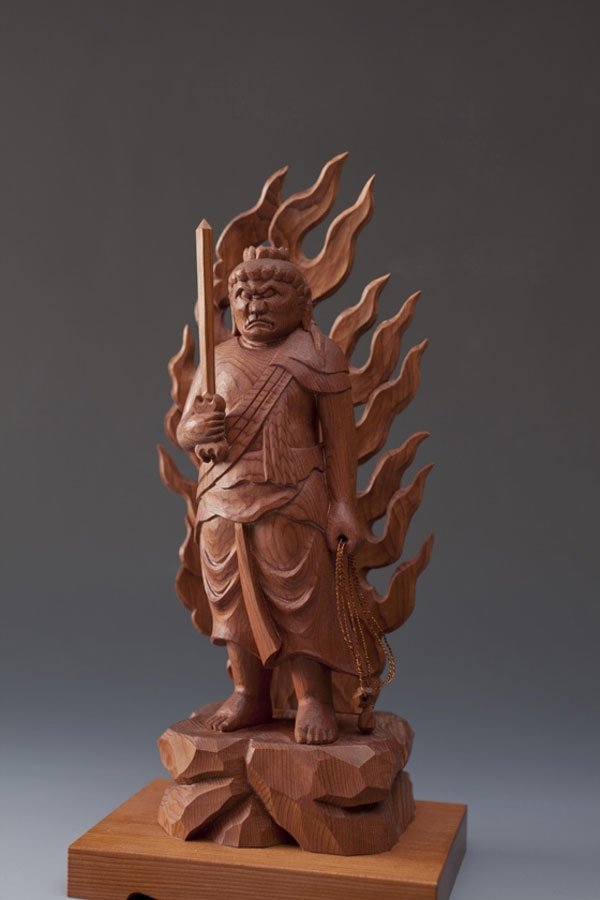 Photo:Gifu Prefecture
Photo:Gifu Prefecture
- Wood, bamboo crafts
- Gifu
Ichii woodcarvings Ichii itto bori
Intricately carved pieces
displaying the natural beauty of wood grain and color
Description
What is Ichii woodcarvings ?
Ichii woodcarvings (called Ichii itto bori in Japanese) are produced in the Hida region of Gifu prefecture, and made only from the wood of ichii (Japanese yew), the prefectural tree of Gifu. The ichii tree gets its name from a scepter made of Japanese yew wood that was presented around eight hundred years ago to the emperor for his coronation. The beauty and high quality of the scepter earned the title sho ichii (the highest rank) and led to the tree being called ichii.
This craft is notable for the use of wood from Hida that is between four hundred to five hundred years old, being carved with only chisels, and not being colored in order to bring out the natural beauty of the wood grain.
The wood has a red toned heartwood in the center and white toned sapwood on the outer rings. This coloration gives the woodcarving pieces their individuality. Over time, the color of the wood changes and a sheen develops which is another appeal of this craft. Nowadays, in addition to traditional netsuke*, decorative objects, and tea ceremony utensils, modern items like cellphone accessories are produced.
*A netsuke is a toggle for hanging a small purse or tobacco pouch from a cord attached to the belt of a kimono.
History

Ichii woodcarving was established by Sukenaga MATSUDA during the later half of the Edo period (1603-1868). Since his family was in the business of producing chopsticks, he learned carving and became a woodcarver. One day, when he saw a heavily painted doll made in the Nara region, he thought it was a waste that the beauty of the wood grain and carving was hidden, which is what led him to make unpainted Ichii woodcarvings. It is written that Matsuda wanted to make the maximum use of the beauty of natural wood, and conducted research focusing on ichii wood because of its attractive wood grain, two distinctive colors, luster, and ease of carving. Originally, Matsuda was a netsuke carver and used the Ichii woodcarving style to produce a great number of them. The superb Ichii woodcarving techniques spread throughout the region and were developed among master craftsmen. In 1975, Ichii woodcarving was designated as a National Traditional Craft. As a specialty of the Hida region, the craft is still being passed down through the generations.
General Production Process
- 1. Preparing the timber
The wood grain patterns and the color shading of naturally-dried ichii timber is inspected and suitable pieces selected. As no coloring will be used, the natural wood color and grain is very important. The timber is then cut to size and shaped roughly with a power saw. For this step, a paper pattern is sometimes used.
- 2. Outlining
The Ichii woodcarving range includes a variety of different sizes and pieces such as decorative objects, masks, and small items. In this stage, a rough draft of the image is created according to the image of the work.
- 3. Rough carving
Most of the production process of Ichii woodcarving is hand-carving work, and depending on the production stage, different types of blades are used such as gouges and borers. In rough carving, artisans freely knock the wood into a rough shape, after which it is sometimes left to dry for two to three days before moving to the next stage.
- 4. Semi-finish carving
Using a variety of small and large chisels, the work is more closely carved, with great attention paid to the overall balance of the piece.
- 5. Finish carving
Finally, any intricate and delicate parts are carved with great care as with Ichii wood, any chisel marks are left as they are. Every single cut greatly affects the finished work and is a test of the artisan's abilities. Depending on the work, it may take one week or more to complete this step.
- 6. Wax-finishing
Lastly, melted white wax is applied and polished with a dry cloth. The wax prevents the wood from cracking or getting dirty and effectively draws out the oiliness of the wood. Over time, this craft will develop luster and sheen.
Where to Buy & More Information
Sakai Dento Sangyo Kaikan
-
Address
-
Tel.+81-577-35-0370
-
ClosedDecember 28 to January 1
-
Business Hours9am to 5pm
-
Website
See more Wood, bamboo crafts
- Hakone wood mosaic
- Iwayado traditional chest
- Kaba cherrybark woodcrafts
- Odate bentwood
- Inami wood carvings
- Matsumoto furniture
- Beppu bamboo crafts
- Edo wood joinery
- Ichii woodcarvings
- Suruga bamboo crafts
- Edo bamboo fishing rods
- Kishu bamboo fishing rods
- Kamo traditional chest
- Kyo wood joinery
- Miyakonojo archery bows
- Osaka carved wooden panel
- Miyajima woodwork
- Nibutani carved wooden tray
- Okuaizu Basketry
- Echizen traditional chest
- Kasukabe traditional paulownia chest
- Katsuyama bamboo crafts
- Osaka karaki wood joinery
- Takayama tea whisks
- Toyooka wicker crafts
- Akita cedar tubs and barrels
- Nagiso woodturning
- Kishu traditional chest
- Nagoya traditional paulownia chest
- Osaka bamboo screens
- Osaka-senshu traditional paulownia chest
- Sendai traditional chest































































































































































































































































































